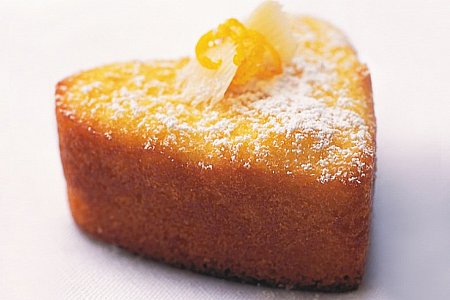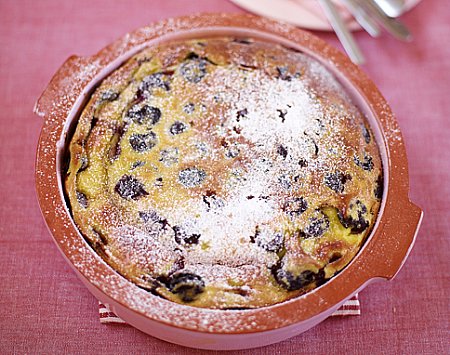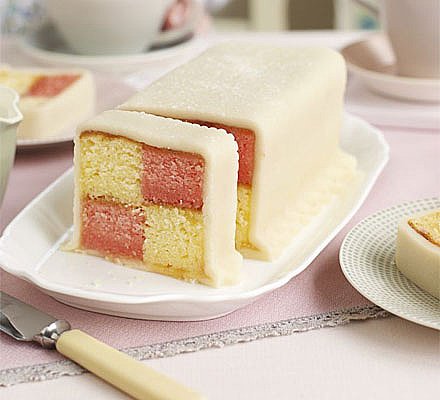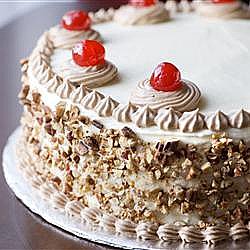Travel Features
Around The World in Cakey Days
By Jade Clayton
Most will agree that experiencing local food and drinks is a big part of travelling. Whether you want to be reminded of a nice holiday, or just fancy trying out something different, we have put together a selection of dessert recipes to take you on a tour around the world in the comfort of your own kitchen. Go on, challenge yourself to a Great British Bake Off (or International Bake Off for that matter)!

Spain – Almond & Orange Cake
Almond and Orange cake is based on the traditional ‘Tarta de Santiago' which is a special almond cake recipe originating from the beautiful and underexplored Galicia region in northern Spain. This miniature flourless, butterless gluten-free cake is a very popular dessert with the Spanish regions and dates back centuries.
Ingredients
2 large navel oranges, (choose oranges with unblemished skins as the whole fruit is used in this recipe)
5 eggs
1 1/4 cups (250g) caster sugar
2 1/2 cups (250g) ground almonds
1 teaspoon gluten-free baking powder
Pure icing sugar to serve
Method
Heat the oven to 170°C. In a heart shaped tin grease and line the base – if not heart shaped, any baking tin will do.
In a saucepan cover two whole oranges with water and bring to the boil, letting it simmer - leave covered for 1 hour making sure the oranges remain covered with water. Once drained and cooled, quarter the oranges, discarding of any seeds. Then place the chunks into a blender and puree till smooth.
Mix the eggs with sugar until thick, then adding the orange puree, ground almonds and baking powder altogether.
Pour the mixture in prepared tin and bake for 1 hour. Once baked leave the cake to firm for 20 minutes before turning out, remove the baking paper and turn over to finish cooling right way up. This cake can be prepared up to 48 hours in advance.
For serving, sift icing sugar on top and decorate with orange zest and almonds.
Recipe source

France – Cherry Clafoutis
A particular favourite in the green and rural region of Limousin in France, this combination of cherries and batter mixture is superb as a light summer dessert and although very much a French dessert, Cherry Clafoutis is fast becoming a popular treat in coffee shops throughout Europe.
Ingredients
½ tbsp butter, softened, for greasing
1 tbsp sugar
300g cherries, stoned if you prefer
Icing sugar, for dusting
Batter
60g flour
½ tsp baking powder
3 eggs
60g sugar
300ml milk
½ tsp vanilla extract
Method
Firstly heat the oven to 180C/gas 4. Mix all the batter base ingredients in a blender until totally smooth adding a pinch of salt, then set aside for 20–30 minutes.
Then grease a round baking dish with butter, then sprinkling over sugar. Dot the cherries around the base of the dish and put in the oven for 5 minutes so the fruit can begin to soften.
Once done remove dish from oven and pour the batter over until the cherries are just covered. Put back in the oven to bake for about 30–35 minutes. Dust the clafoutis with icing sugar and serve lukewarm.
Recipe source

UK – Battenberg Cake
Despite a distinctively German name, the Battenberg Cake is throughoutly British. Over many years the square roll has been known under many different names including the “Domino Cake”, "Neapolitan Roll" and “Church Window Cake”. This traditional English cake is a firm favourite amongst UK households, perfect with a cup of tea! Alternative versions include this very patriotic
Union Jack Battenberg and a rainbow version seen in coffee shops in trendy parts of London.
Ingredients
For almond sponge
175g very soft butter
175g golden caster sugar
140g self-raising flour
50g ground almonds
½ tsp baking powder
3 medium eggs
½ tsp vanilla extract
¼ tsp almond extract
For pink sponge
1 x ingredients for almond sponge
pink food colouring, we used ½ tsp Squires rose food paste
To assemble
200g apricot jam
2 x 500g blocks white marzipan
little icing sugar, for dusting
Method
Firstly pre heat the oven to 180C/160C fan/gas 4 then line the base and sides of a square tin (20cm) with baking paper. For the almond sponge, place butter, sugar, flour, ground almonds, baking powder, eggs, vanilla and almond extract in a bowl. With an electric whisk beat mixture until smooth, scrape the mix into the tin, spreading right to the corners, and bake for 25-30 mins . Once baked leave to cool in the tin for 10 mins, then transfer to a wire rack to finish cooling while you make the second sponge.
For the pink sponge, line the tin as above. Mix all the ingredients together as above, without the almond extract and add in some pink food colouring. Then scrape it all into the tin and bake as before, leave to cool.
For assembling, heat the jam in a pan until runny, then sieve. Slightly trim two opposite edges from the almond sponge use a ruler to help you cut 4 slices each the same width as the sponge height. Nibble any leftover sponge and repeat with pink cake.
Using 2 x almond slices and 2 x pink slices that are all the same length, lightly dust the surface with icing sugar and roll out one marzipan block to just over 20cm wide, roll the marzipan until roughly 0.5cm thick. Brush with apricot jam and then lay a pink and an almond slice side by side at one end of the marzipan, brushing jam in between to stick sponges also, and leaving 4cm clear marzipan at the end. Brush more jam on top of the sponges, then sandwich remaining 2 slices on top, alternating colours to give a checker board effect and trim the marzipan to the length of the cakes.
Carefully lift up the marzipan and smooth over the cake with your hands, but leave a small marzipan fold along the bottom edge before you stick it to the first side. Trim any excess .
Assemble second Battenberg and keep in an airtight box or well wrapped in cling film for up to 3 days. Can be frozen for up to a month.
Recipe source

Italy – Classic Italian Cream Cake
Popular in North America, Italian cream cakes can be traced back to the early 1900s when demand for rich ingredients started to increase. However, nobody can be sure if this cake originates in Italy as the name suggests, or from Southern United States as many believe. It is generally said that Italian cream cakes are related to trifles because of the use of sponge, cream and other flavours. If you have not made one before, this classic recipe is excellent for your first attempt and will surely bring that feeling of holidays in Italy to your kitchen.
Ingredients
1/2 cup margarine, softened
1/2 cup shortening
2 cups white sugar
5 egg yolks
2 cups all-purpose flour
1 teaspoon baking soda
1 cup buttermilk
1 teaspoon vanilla extract
1 1/3 cups flaked coconut
1 cup chopped pecans
5 egg whites
8 ounces cream cheese
1/2 cup margarine, softened
4 cups confectioners' sugar
1 teaspoon vanilla extract
1/2 cup chopped pecans
Method
At about 350 degrees F (175 degrees C) pre heat oven, then flour and grease three 8 inch cake pans (round).
Beat the egg whites until stiff peaks form.
In a bowl, cream 1/2 cup margarine and shortening till light. Add white sugar, and mix until fluffy. Then beat in egg yolks. Stir together the flour and baking soda, and add buttermilk into the creamed mixture alternately; beat well after each addition. Stir in 1 teaspoon vanilla, coconut, and 1 cup pecans. Fold in stiffly beaten egg whites and spoon into prepared tins.
Bake for 25 to 40 minutes. Cool in tins for 10 minutes then remove to wire rack to cool completely.
For frosting combine cream cheese, 1/2 cup margarine, confectioners' sugar, and 1 teaspoon vanilla in a bowl. Mix till smooth and add coconut if desired. Frost the cooled cake. The remaining 1/2 cup pecans can be sprinkled onto the cake after it is frosted.
Recipe source

The Caribbean – Rum Cake
It's no secret that rum is a signature ingredient amongst Caribbean dessert recipes. This traditional rum cake recipe is a prime example and is very beloved in that part of the world including the colourful Jamaica in the west, beautiful St. Lucia island and Barbados in the east of the Caribbean. Rum cake can also come in a lot of different variations but the majority are based around the same basic ingredients.
Ingredients
For the Cake
1 cup chopped walnuts
1¾ cups all-purpose flour
¼ cup cornstarch
4 teaspoons baking powder
1 teaspoon kosher salt
½ cup unsalted butter, at room temperature
1½ cups granulated sugar
3 tablespoons + ½ cup canola oil, divided
1 cup instant vanilla pudding mix (or one 3.4-ounce package of instant vanilla pudding)
4 eggs
¾ cup whole milk
¾ cup dark rum
1 tablespoon vanilla extract
For the Rum Syrup
¾ cup unsalted butter
1½ cups granulated sugar
¼ cup water
Pinch of salt
½ cup dark rum
Method
Heat the oven at 325F, in a Bundt cake tin grease and flour the inside. Sprinkle the chopped walnuts around the bottom and set aside until later.
Then in a bowl whisk flour, cornstarch, baking powder, and salt also leaving that to one side for later.
With an electric mixer, combined together butter and granulated sugar until fluffy and light. Add the flour mixture and 3 tablespoons of canola oil, mixing for a further minute or two – at this stage the mixture should look like wet sand. Add the pudding mix and mix again until completely mixed together.
After this, whisk together the eggs, milk, rum, remaining ½ cup canola oil, and vanilla extract. Then adding the egg mixture to the dry ingredients and mixing until thoroughly combined, scraping the sides of the bowl as needed. (The batter will be quite thin - this is good! It will be nice and moist!)
Pour the cake batter into the prepared Bundt tin and bake for about 60 minutes; you can test this inserting a knife into the centre – if done the knife will come out clean.
At about 50 minutes bake time, start the rum syrup. Melt butter in a pan over medium heat, once melted; add the sugar and the water. Boil for 5 minutes, constantly stirring. Turn off the heat and stir in the rum. Once it is mixed, return it to heat for about 30 seconds.
When the cake is out the oven, pour about one-third of the rum syrup over the bottom of the cake immediately. Pouring slowly so it has time to seep into the cake. Let it sit for 5 minutes.
Turn the cake onto a serving platter, using a fork or a skewer, poke holes all over the cake and slowly, slowy pour the remaining rum syrup over the top of the cake, so that the syrup actually seeps into the cake and doesn't just pool on the bottom of the serving dish.
Allow the cake to cool to room temperature before serving. Leftovers can be kept, wrapped, for up to 5 days at room temperature.
Recipe source

USA – Banoffee Cheesecake with Toffee Pecan Sauce
‘Banoffee' = Banana + Toffee, an original title for this famous sweet dish. Although cheesecakes are largely associated with America, in particular the popular New York style, history traces this back to ancient Greece. This twist on the classic cheese cake is a light combination of banana, toffee and cream set on a biscuit base usually top with grated chocolate or pecans. The toffee pecan sauce adds an extra velvety dimension to the dessert, definitely one for those who have a sweet tooth!
Ingredients
For the base
3 oz (75 g) pecan nuts (use half for the base and half for the sauce)
4 oz (110 g) sweet oat biscuits
1½ oz (40 g) melted butter
For the filling
3 medium-size ripe bananas (8 oz/225 g peeled weight)
1 tablespoon lemon juice
3 large eggs
12 oz (350 g) medium-fat curd cheese
1 x 200 g tub fromage frais (8 per cent fat)
6 oz (175 g) caster sugar
For the sauce
2 oz (50 g) butter
3 oz (75 g) soft brown sugar
2 oz (50 g) granulated sugar
5 oz (150 g) golden syrup
5 fl oz (150 ml) double cream
a few drops vanilla extract
For the topping
3 medium-size ripe bananas
2 tablespoons lemon juice
Method
Begin the Banoffee Cheesecake by toasting all the pecan nuts in a pan or for a few minutes in the oven.
Then chop them up into small pieces. Then crush the biscuits with a rolling pin and place in a bowl, add melted butter and half the nuts. Mixing well and then pressing the biscuit mixture into the bottom of the cake tin and pre-bake in the oven for about 10 minutes. Then lower the temperature to gas mark 2, 300ºF (150ºC).
For the filling, firstly blend the 3 bananas and lemon juice in until smooth, then simply add the rest of the filling ingredients. Blending again, then pour the mixture over the biscuit base and bake for 1 hour, ideally on the middle shelf. Once baked turn off the oven and leave the cheesecake inside to cool slowly until completely cold; this slow cooling will stop the cheesecake cracking.
For the sauce, put the butter, sugars and syrup in a small pan and dissolved over a very low heat. Let it cook for about 5 minutes then add in in the cream and vanilla extract and stir until everything is smooth, add the rest of the chopped pecan nuts. Remove it from the heat and allow it to cool completely before pouring it into a jug ready for serving.
Serve the cheesecake in slices with sliced banana on top, accompanied by the rest of the sauce.
Recipe source

Brazil – Carrot Cake with Chocolate
Unlike other traditional carrot cakes this version from Brazil in South America called "Bolo de Cenoura" is well worth a try. This authentic recipe is a mouth-watering favourite with a smooth carrot sponge (no bits or carrot shavings), topped with chocolate icing.
Ingredients
250ml vegetable oil
400g caster sugar
4 large eggs
3 medium carrots, peeled and sliced
300g plain flour
1 tablespoon baking powder
Chocolate icing
250ml milk
1 tablespoon butter
2 tablespoons honey
100g cooking chocolate
Method
Firstly pre heat oven to 180 C or Gas mark 4 - grease and flour a medium size cake tin (20x30cm).
In a food processor or blender mix oil, sugar, eggs and carrots - blending until smooth.
Then pour the carrot mixture into a bowl and sift in the flour and baking powder. Mix well and pour the cake mixture into your prepared cake tin.
Bake in the preheated oven for 40 minutes. Let cool, remove from tin and ice.
Chocolate icing
Bring all icing ingredients to the boil over medium heat, constantly stirring. Lower the heat and simmer for a further 5 minutes, until the mixture thickens. Allow the icing to cool slightly, then pour over the cooled cake.
Recipe source

India – Cardamom Cake
Cardamom is a popular ingredient used in Indian and Asian cooking, the aromatic smell brings you right back to holidays in India. Although it is used mainly in savoury dishes there are some classic dessert dishes which make use of this wonderful spice too. The cardamom and coffee in this recipe work very well together, creating a unique and superb tasting cake.
Ingredients
50g shelled unsalted pistachios
seeds from 10 green cardamom pods
115g self-raising flour
1 level teaspoon baking powder
115g spreadable butter
2 large eggs
115g golden caster sugar
1 tablespoon instant espresso coffee powder
For the syrup
1 slightly rounded dessertspoon instant espresso coffee powder
the seeds from 10 green cardamom pods
1 level tablespoon demerara sugar
25ml boiling water
For the filling and topping
250g mascarpone
1 rounded dessertspoon instant espresso coffee powder
1 tablespoon golden caster sugar
1–2 tablespoons milk
50g shelled unsalted pistachios
Method
First of all roast all pistachios on a tray in the oven for 8 minutes.
While that's happening, place the 10 cardamom pods for the cake in a pestle and mortar, crush until pods open, then remove the seeds into a saucepan. Now do the same with 10 pods, using a separate pan.
Next discard all the pods and grind each lot of seeds to a fine powder whilst keeping them separate,. When the nuts are ready, chop half of them finely and keep the rest for the topping.
For the cake, sift flour and baking powder into a large bowl; give the flour a good airing by sieving quite high. Then add butter, eggs, caster sugar, instant espresso and one saucer of cardamom powder, and then use an electric hand whisk to mix until smooth and creamy.
After that add the chopped nuts into the mixture by gently folding, then divide the mixture between the two prepared baking tins, level out using spoon and bake in the oven for about 25 minutes.
Meanwhile you can make up the syrup and the topping. Place the coffee powder, the other saucer of crushed cardamom and sugar in a heatproof dish, measure in boiling water and whisk for about one minute until the coffee and sugar have dissolved.
For the filling and topping, except the pistachios whisk all the ingredients together in another bowl. Check the cakes are cooked by pressing lightly with your little finger in the centre – it should spring back if ready.
Then remove them from the oven leaving them in their tins. Prick them all over with a folk or skewer while they are still hot and slowly drape the syrup evenly over each one, leaving them to soak as they cool in their tins.
When cold, loosen the edges of the tin with a knife, then place each one on an upturned bowl and carefully slide the outer edge of the tin downwards. Choose your serving plate and again use a knife to gently slide one cake off its liner onto the plate.
Now spread half the filling mixture over the first cake. Then (as above) slide the other cake carefully on top, and spread with the rest mixture.
For finishing, scatter the roasted pistachios all over just before serving.
Recipe source
Feel free to forward this on to your dessert-loving friends or post any unique dessert recipes you would like to share with us below.






